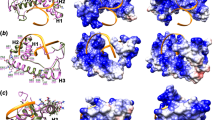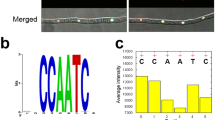Abstract
The CCAAT-binding complex in the Aspergillus species, also known as the Hap complex, consists of at least three subunits, namely HapB, HapC and HapE. Each Hap subunit contains an evolutionary conserved core domain. Recently, we have found that the HapC and HapE subunits do not carry a nuclear localisation signal. Furthermore, when in complex with HapB, they are transported into the nucleus via a ‘piggy back mechanism’ in A. nidulans. To extend our findings to other filamentous fungi, we examined the nuclear localisation of the A. oryzae Hap subunits by analysing several GFP fusion proteins with these Hap subunits in the hap deletion strains of A. nidulans. The nuclear translocation of the A. oryzae complex was found to be dependent on two redundant localising signals in HapB.




Similar content being viewed by others
References
Ballance DJ, Turner G (1985) Development of a high-frequency transforming vector for Aspergillus nidulans. Gene 36:321–331
Baxevanis AD, Arents G, Moudrianakis EN, Landsman D (1995) A variety of DNA-binding and multimeric proteins contain the histone fold motif. Nucleic Acid Res 23:2685–2691
A cDNA encoding a human CCAAT-binding protein cloned by functional complementation in yeast. Proc Natl Acad Sci USA 88:1968–1972
Brakhage AA, Andrianopoulos A, Kato M, Steidl S, Davis MA, Tsukagoshi N, Hynes MJ (1999) HAP-Like CCAAT-binding complexes in filamentous fungi: implications for biotechnology. Fungal Genet Biol 27:243–252
Bucher P (1990) Weight matrix descriptions of four eukaryotic RNA polymerase II promoter elements derived from 502 unrelated promoter sequences. J Mol Biol 212:563–578
Caretti G, Cocchiarella F, Sidoli C, Villard J, Peretti M, Reith W, Mantovani R (2000) Dissection of functional NF-Y-RFX cooperative interactions of the MHC class II Ea promoter. J Mol Biol 302:539–552
Chikamatsu G, Shirai K, Kato M, Kobayashi T, Tsukagoshi N (1999) Structure and expression properties of the endo-β-1, 4-glucanase A gene from the filamentous fungus Aspergillus nidulans. FEMS Microbiol Lett 175:239–245
Chiu W, Niwa Y, Zeng W, Hirano T, Kobayashi H, Sheen J (1996) Engineered GFP as a vital reporter in plants. Curr Biol 6:325–330
Dooley KA, Millinder S, Osborne TF (1998) Sterol regulation of 3-hydroxy-3-methylglutaryl-coenzyme A synthase gene through a direct interaction between sterol regulatory element binding protein and the trimeric CCAAT-binding protein. J Biol Chem 273:1349–1356
Hanahan D (1983) Studies on transformation of Escherichia coli with plasmids. J Mol Biol 166:557–580
Kato M, Aoyama A, Naruse F, Kobayashi T, Tsukagoshi N (1997) An Aspergillus nidulans nuclear protein, AnCP, involved in enhancement of Taka-amylase A gene expression, binds to the CCAAT-containing taaG2, amdS, and gatA promoters. Mol Gen Genet 254:119–126
Kato M, Aoyama A, Naruse F, Tateyama Y, Hayashi K, Miyazaki M, Papagiannopoulos P, Davis MA, Hynes MJ, Kobayashi T, Tsukagoshi N. (1998) The Aspergillus nidulans CCAAT-binding factor AnCP/AnCF is a heteromeric protein analogous to the HAP complex of Saccharomyces cerevisiae. Mol Gen Genet 257:404–411
Kato M, Hayashi K, Kobayashi T, Tsukagoshi N. (2000) A simple and rapid method for the preparation of a cell-free extract with CCAAT-binding activity from filamentous fungi. Biosci Biotechnol Biochem 64:455–457
Kato M, Tateyama Y, Hayashi K, Naruse F, Oonishi R, Tanoue S, Tanaka A, Kobayashi T, Tsukagoshi N (2002) A quantity control mechanism regulating levels of the HapE subunit of the Hap complex in Aspergillus nidulans: no accumulation of HapE in hapC deletion mutants. FEBS Lett 512:227–229
McNabb DS, Xing Y, Guarente L (1995) Cloning of yeast HAP5: a novel subunit of a heterotrimeric complex required for CCAAT binding. Genes Dev 9:47–58
Mimura S, Rao U, Yoshino S, Kato M, Tsukagoshi N (1998) Depression of the xylanase-encoding cgxA gene of Chaetomium gracile in Aspergillus nidulans. Microbiol Res 153:369–376
Motoyama T, Fujiwara M, Kojima N, Horiuchi H, Ohta A, Takagi M (1996) The Aspergillus nidulans genes chsA and chsD encode chitin synthases which have redundant functions in conidia formation. Mol Gen Genet 251:442–450
Nakai K, Horton P (1999) PSORT: a program for detecting the sorting signals of proteins and predicting their subcellular localization. Trends Biochem Sci 24:34–35
Papagiannopoulos P., Andrianopoulos A, Sharp JA, Davis MA, Hynes MJ (1996) The hapC gene of Aspergillus nidulans is involved in the expression of CCAAT-containing promoters. Mol Gen Genet 251:412–421
Pontecorvo G, Roper JA, Hemmons LM, Macdonald KD, Bufton AW (1953) The genetics of Aspergillus nidulans. Adv Genet 5:141–238
Rowlands RT, Turner G. (1973) Nuclear and extranuclear inheritance of oligomycin resistance in Aspergillus nidulans. Mol Gen Genet 126:201–216
Sinha S, Maity SN, Lu J, de Crombruggle B (1995) Recombinant rat CBF-C, the third subunit of CBF/NFY, allows formation of a protein-DNA complex with CBF-A and CBF-B and with yeast HAP2 and HAP3. Proc Natl Acad Sci USA 92:1624–1628
Steidl S, Papagiannopoulos P, Litzka O, Andrianopoulos A, Davis MA, Brakhage AA, Hynes MJ (1999) AnCF, the CCAAT binding complex of Aspergillus nidulans, contains products of the hapB, hapC, and hapE genes and is required for activation by the pathway-specific regulatory gene amdR. Mol Cell Biol 19:99–106
Steidl S, Tüncher A, Goda H, Guder C, Papadopoulou N, Kobayashi T, Tsukagoshi N, Kato M, Brakhage AA (2004) A single subunit of a heterotrimeric CCAAT-binding complex carries a nuclear localization signal: piggy back transport of the pre-assembled complex to the nucleus. J Mol Biol 342:515–524
Sybirna K, Guiard B, Li YF, Bao WG, Bolotin-Fukuhara M, Delahodde A (2005) A new Hansenula polymorpha HAP4 homologue which contains only the N-terminal conserved domain of the protein is fully functional in Saccharomyces cerevisiae. Curr Genet 47:172–181
Taira T, Sawai M, Ikeda M, Tamai K, Iguchi-Ariga SMM, Ariga H (1999) Cell cycle-dependent switch of up- and down-regulation of human hsp70 gene expression by interaction between c-Myc and CBF/NF-Y. J Biol Chem 274:24270–24279
Tanaka A, Kato M, Hashimoto H, Kamei K, Naruse F, Papagiannopolous P, Davis MA, Hynes MJ, Kobayashi T, Tsukagoshi N (2000) An Aspergillus oryzae CCAAT-binding protein, AoCP, is involved in the high-level expression of the Taka-amylase A gene. Curr Genet 37:380–387
Tanaka A, Kamei K, Tanoue S, Papagiannopolous P, Steidl S, Brakhage AA, Davis MA, Hynes MJ, Kato M, Kobayashi T, Tsukagoshi N (2001) AoHapB, AoHapC and AoHapE, subunits of the Aspergillus oryzae CCAAT-binding complex, are functionally interchangeable with the corresponding subunits in Aspergillus nidulans. Curr Genet 39:175–182
Tanaka A, Kato M, Nagase T, Kobayashi T, Tsukagoshi N (2002) Isolation of genes encoding novel transcription factors which interact with the Hap complex from Aspergillus species. Biochim Biophys Acta 1576:176–182
Tsukagoshi N, Kobayashi T, Kato M (2001) Regulation of the amylolytic and (hemi-) cellulolytic genes in aspergilli. J Gen Appl Microbiol 47:1–19
Ueda A, Takeshita F, Yamashiro S, Yoshimura T (1998) Positive regulation of the human macrophage stimulating protein gene transcription. Identification of a new hepatocyte nuclear factor-4 (HNF-4) binding element and evidence that indicates direct association between NF-Y and HNF-4. J Biol Chem 273:19339–19347
Yoshino S, Oishi M, Moriyama R, Kato M, Tsukagoshi N (1995) Two family G xylanase genes from Chaetomium gracile and their expression in Aspergillus nidulans. Curr Genet 29:73–80
Acknowledgements
We thank Dr. Yasuo Niwa for the generous gift of a plasmid carrying a GFP gene.
Author information
Authors and Affiliations
Corresponding author
Rights and permissions
About this article
Cite this article
Goda, H., Nagase, T., Tanoue, S. et al. Nuclear translocation of the heterotrimeric CCAAT binding factor of Aspergillus oryzae is dependent on two redundant localising signals in a single subunit. Arch Microbiol 184, 93–100 (2005). https://doi.org/10.1007/s00203-005-0014-3
Received:
Revised:
Accepted:
Published:
Issue Date:
DOI: https://doi.org/10.1007/s00203-005-0014-3




